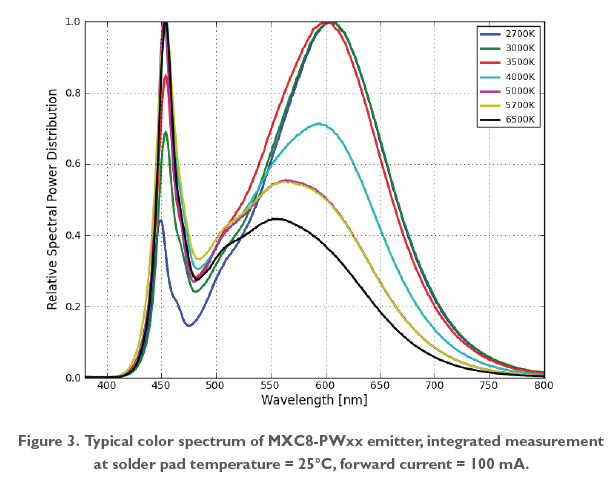About - Publications - Blog
Standards for typical light sources
Illuminants
The International Commission on Illumination (CIE) is responsible for publishing binding standards for different types of light sources, called "illuminants". A standard illuminant represents a mathematical table of relative energy versus wavelength, used for colorimetric calculations. It is a (theoretical) source of visible light with a set spectrum, determined by convention and therefore provide a worldwide basis for comparing images under different lighting.
What are useful standards for indoor illumination? I consider some typical light sources for indoor environments (residential and commercial) and try to find an appropriate illuminant (standard).
This post was a preparatory study for the open-access article
Minnaert, B.; Veelaert, P. A
Proposal for Typical Artificial Light Sources for the Characterization of Indoor
Photovoltaic Applications. Energies 2014, 7, 1500-1516.
Some figures were taken from the article, with permission of course.
The incandescent lamp
Let's start with the most common lamp, an incandescent lamp (you know, the one everybody thinks Edison invented, but apparently he did not).
Fortunately, that's an easy one. The CIE has agreed upon a standard for the
incandescent light bulb, called "illuminant A":
Illuminant A is intended to represent typical, domestic, tungsten-filament lighting. Its relative spectral power distribution is that of a Planckian radiator at a temperature of approximately 2856 K. CIE standard illuminant A should be used in all applications of colorimetry involving the use of incandescent lighting, unless there are specific reasons for using a different illuminant.
In other words, a typical light bulb can be characterised by a black body on temperature T = 2856 K. The CIE has a table (page 30 in reference [1]) and formula (page 2 in ref. [1]) (simply a derivation [2] from Planck's spectrum) for illuminant A. Technically, illuminant A is defined over the spectral region from 300 nm to 830 nm to six significant digits. But let us simply use Planck's law on T=2856 K.
The illuminants are relative defined, in other words, in a.u. (arbitrary units). In the figure below, I plotted illuminant A, well beyond its "defined region" of 300-830 nm, and in units of W/m².sr.nm.
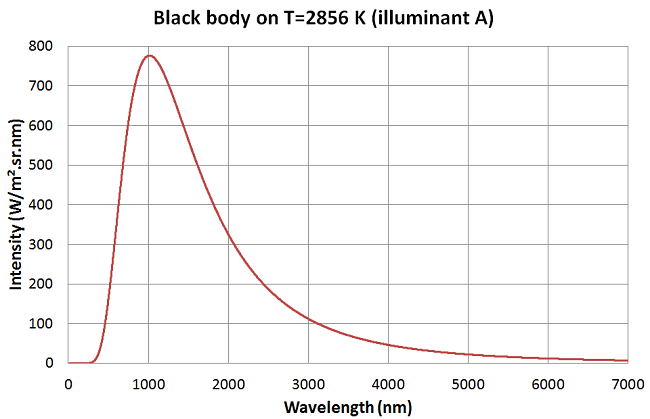
In the following figure, I plotted a comparison between the definition of the standard illuminant A according to the predefined table given in [1], and the calculation according to Planck's law (normalised on the same value, in a.u).
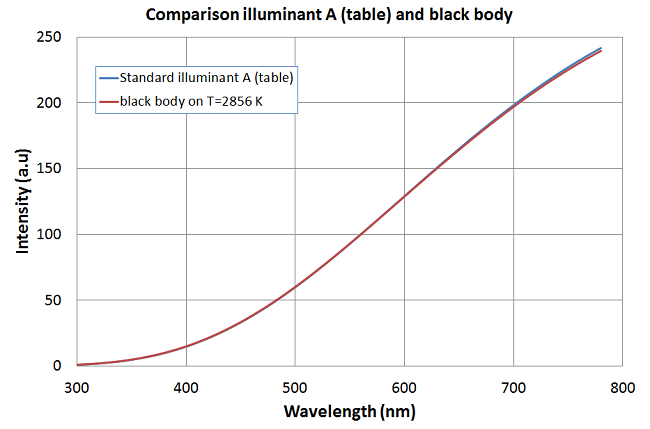
As you can see (or not), the difference is negligible. The higher the wavelength, the higher the difference. Here's a zoom of the region 700-780 nm:
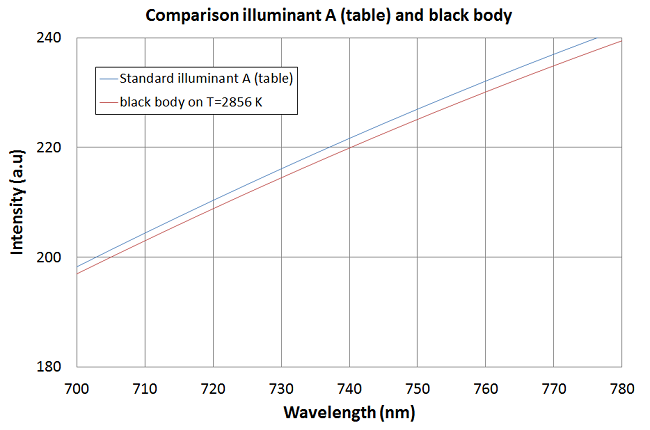
The difference remains negligible. E.g., for a wavelength of 770 nm, the datapoint from the table is 0.89% higher than the calculations from Planck's law.
Fluorescent lighting
In the same way a standard for the incandescent light bulb was defined, a standard for the fluorescent tube was decided upon. Because there are a lot of different types of fluorescent tubes, twelve illuminants were defined, named F1 to F12 (sometimes named FL1 to FL12).
- F1 to F6 represent "standard" fluorescent tubes. Those consist of two semi-broadband emissions of antimony and manganese activations in calcium halophosphate phosphor.
- F7 to F9 are broadband fluorescent lamps with multiple phosphors.
- F10 to F12 consist of three narrowband emissions (caused by ternary compositions of rare-earth phosphors).
The values of the illuminants can be found in reference [1], more specifically in table T.6: "Relative spectral power distributions of illuminants representing typical fluorescent lamps, for wavelengths from 380 nm to 780 nm at 5 nm intervals."
A footnote in this reference gives an interesting guideline:
Illuminants FL2, FL7 and FL11 should take priority over others when a few typical fluorescent lamp illuminants are to be selected.
So who am I to oppose this advice? It are the fluorescent tubes most commonly used in the industry.
As typical standards for fluorescent lighting, I choose the illuminants F2, F7 and F11. What kind of fluorescent tubes do these illuminants represent?
- F2: cool white fluorescent lamp (correlated color temperature CCT = 4230 K). They make up the majority of office illumination.
- F7: broad-band fluorescent lamp (CCT = 6500 K). This lamp is an approximation of the illuminant D65. This illuminant is intended to represent average daylight (It corresponds roughly to a midday sun in Western Europe / Northern Europe, and is therefore also called a daylight illuminant).
- F11: narrow tri-band fluorescent lamp (CCT = 4000 K). They are mostly used as warehouse lighting.
Interim remark: the higher the correlated color temperature CCT, the "cooler" the lamp appears to the human eye. Indeed, the higher the temperature of a black body, the lower the wavelength of the top (maximum intensity) of Planck's spectrum and thus the bluer ("cooler") the light.
Summary:
- F2: white office lamp
- F7: daylight lamp
- F11: warehouse lamp
In the figure below, I plotted the illuminants F2, F7 and F11 within the defined region.
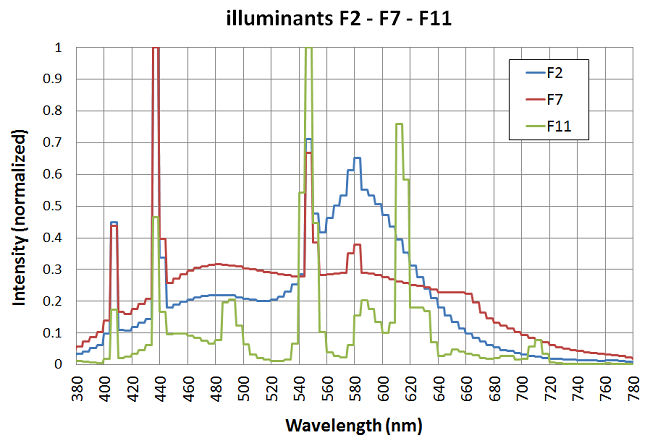
Concluding remark: the relative spectral power distribution of the FL-illuminants can only be used over the spectral range from 380 nm to 780 nm. Although many fluorescent lamps emit power outside this spectral range, especially in the near ultraviolet, other sources of data must be consulted if information is required below 380 nm or above 780 nm. However, as far as I can tell, the power outside this spectral range can be neglected for these 3 typical fluorescent tubes.
High pressure discharge lamps
Finding useful standards for indoor illumination caused by high pressure sodium and metal halide lamps are straightforward. The values of the illuminants can be found in reference [1], table T.7. "High pressure discharge lamps. HP1: Standard high pressure sodium lamp; HP2: Colour enhanced high pressure sodium lamp; HP3-5: Three types of high pressure metal halide lamps" I choose HP1 for the high pressure sodium lamp and HP5 for the metal halide lamp.
Again, the relative spectral power distribution of the HP-illuminants given here can only be used over the spectral range from 380 nm to 780 nm. Although many high pressure gas discharge lamps emit power outside this spectral range, especially in the near ultraviolet, other sources of data must be consulted if information is required below 380 nm or above 780 nm.
I did some digging, and found indeed types of metal halide lamps which emit power in the near UV. However, the (commonly used) type I consider (illuminant HP5) does not emit significant power in the near UV. For the high pressure sodium lamp, I did not find any significant emission below 350 nm.
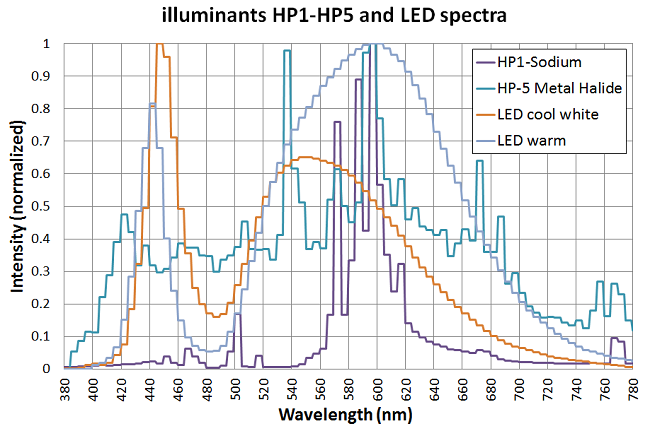
LEDs
I was not that easy to find a standard illuminant for LED lighting. It took me quite some time. The reason is simple: there simply isn't one. There are standards for measuring LED lamps or determining their lifetime, but there is to date no international standard for the spectrum of LED lamps.
Therefore, I did a search for the spectrum of the current commercial LED light, used for indoor lighting (as well for in a residential as in an office environment).
In order to emit white light, necessary for indoor lighting applications, there are 2 possibilities:
- One can mix red, green and blue LEDs (= "RGB LEDs").
- One can use a blue (or UV) LED, covered with a phosphor layer in which the highly energetic blue light is converted to white light.
From [3], one can find the two characteristic spectra of the methods:
Method 1:
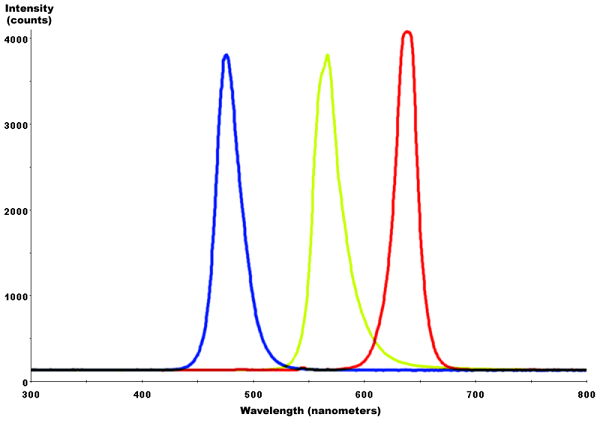
Method 2:
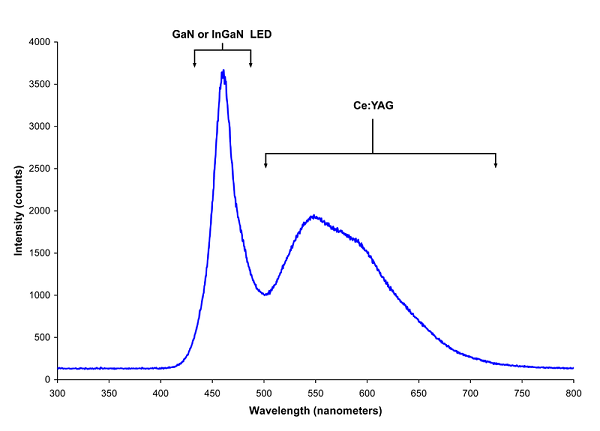
Let us find out which of those two method is used most (maybe both?).
First, I determine the companies who manufacture LED lights. From [4], the top 10 LED suppliers for 2011, by revenue of packaged LED components are:
- Nichia
- Samsung LED
- Osram Opto Semiconductors
- LG Innotek
- Seoul Semiconductor
- Cree
- Philips Lumileds
- Sharp
- TG
- Everlight
Not every company sells LED lights for indoor lighting, or has detailed datasheets with the spectrum.
But Nichia has [5-9]. All relevant LED-lights have more or less one of the following four shapes:

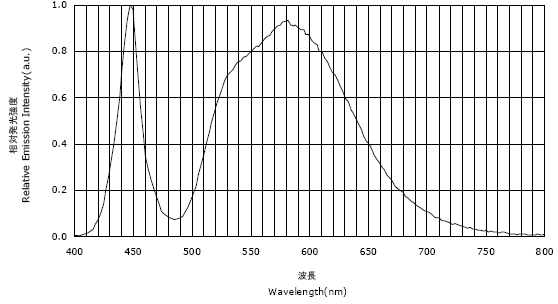
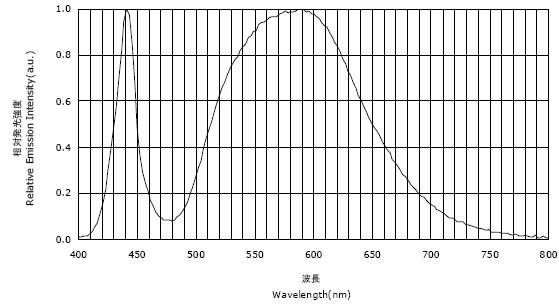
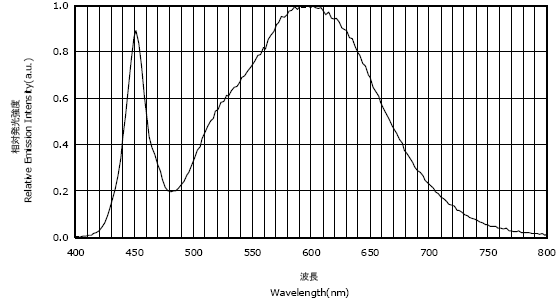
The same can be found at Seoul Semiconductor [10-11]:
And at Philips Lumileds [12]:
And so on...
From these data, we can conclude that there are 2 peaks: one at 440 - 450 nm, caused by the bandgap of InGaN [13]:
The emitted wavelength, dependent on the material's band gap, can be controlled by the GaN/InN ratio, from near ultraviolet for 0.02In/0.98Ga through 390 nm for 0.1In/0.9Ga, violet-blue 420 nm for 0.2In/0.8Ga, to blue 440 nm for 0.3In/0.7Ga, to red for higher ratios and also by the thickness of the InGaN layers which are typically in the range of 2–3 nm.
The other, more broadband, peak at 550 - 600 nm, is caused by the Stokes-shifted light emitted by the phosphor coating. More details can be found in [14] and [15].
Depending on the correlated color temperature (CCT), one peak is higher than the other (or they have the same intensity).
From these conclusions, and with the help of Paul Miller and Michael de Podesta of the National Physical Laboratory (Teddington, UK), I propose two spectra for the LED lights: a cool white and a warm LED spectrum, which can be found on the figure below.
I refer to my article for more details:
Minnaert, B.; Veelaert, P. A
Proposal for Typical Artificial Light Sources for the Characterization of Indoor
Photovoltaic Applications. Energies 2014, 7, 1500-1516.

References
- Technical Report Colorimetry, 3rd edition, CIE 15:2004 - International commission on illumination ISBN 3 901 906 33 9.
- http://en.wikipedia.org/wiki/Standard_illuminant#Illuminant_A
- https://en.wikipedia.org/wiki/Light-emitting_diode
- http://electroiq.com/blog/2012/02/top-10-led-manufacturers-in-2011/
- http://www.nichia.co.jp/en/product/led.html?op=cond=grp1='General_Lighting'
- http://www.nichia.co.jp/specification/en/product/led/NSSW757A-V1-E.pdf
- http://www.nichia.co.jp/specification/en/product/led/NVSL119B-E.pdf
- http://www.nichia.co.jp/specification/en/product/led/NF2L757AR-V1-E.pdf
- http://www.nichia.co.jp/specification/en/product/led/NSSL757A-V1-E.pdf
- http://www.seoulsemicon.com/_upload/Goods_Spec/SAW8KG0A(1).pdf
- http://www.seoulsemicon.com/_upload/Goods_Spec/STW8Q14C(0).pdf
- http://www.philipslumileds.com/products/luxeon-mid-power/luxeon-3535
- https://en.wikipedia.org/wiki/Indium_gallium_nitride
- "Light emitting diodes (LEDs) for general illumination. An Oida Technology roadmap. March 2011".
- https://en.wikipedia.org/wiki/Light-emitting_diode


